7 Best Hydroponic Grow Lights for a Successful Indoor Garden

This post follows our research editorial guidelines.

No matter what hydroponic system you decide to use, a good quality grow light is a must have. The right Grow light will supercharge your rig, and with so many exciting lights on the market today it can be hard to choose. Whether you need something compact for a small set of herbs or a bigger option to provide light to a large number of plants, there’s a high efficiency model out there to get the job done. Here’s what you need to know to pick one that’s best for your grow room.

Table of Contents
Why Use Grow Lights over Sunlight for Indoor Plants?
The most obvious reason to use a grow light instead of just using the sun is convenience. It means you can grow plants in any location that has a power outlet. Northern facing kitchens, windowless basements, balconies shadowed by neighboring buildings – it doesn’t matter. A grow light provides the opportunity to grow in areas with no natural light at all.
The other big reason is consistency. There’s never any worry that a spell of cloudy weather will roll in right at the peak of fruit development and limit your growth. You’ll always have enough light. It also allows you to grow plants all year round, regardless as to how short or snowy the days become.
How do the different types of grow lights work?
All grow lights produce light, but not all that light is the same or has the same ability to promote growth. Each different type of bulb produces its light in different ways.
Incandescent grow lights run electricity through a filament. The filament is usually a material with poor electrical conductivity, so it heats up and begins to glow. Incandescence bulbs as a whole are largely on the way out these days. They’re inefficient, converting much of their electrical uptake to heat rather than light. They also burn out quickly, and to boot produce a light that isn’t always the right type to help a plant grow.
Fluorescent lights aren’t much better. While they’re more efficient and less prone to overheating your plants, they don’t always provide the best full-spectrum support for your plants.
High-intensity discharge (HID) lamps (commonly metal halide and high pressure sodium) are another form of bulb used for grow lights. They run a current through a chamber filled with a noble gas, sparking across a gap between two electrodes. As the electricity flows through the gas it glows brightly. HID lights are some of the most powerful grow lights on the market. They put out intense levels of light and can illuminate a substantially larger indoor grow area than their more energy efficient counterparts.
LED grown lights are my preferred type of plant grow light. They use small LED diodes that emit light when a current passes through them. They’re very efficient, and turn almost all of their electrical uptake into light. Even a large full-spectrum LED light fixture will use less power than an equivalent florescent or HID version. Consequently they’re cheap to run and won’t heat up your grow space.
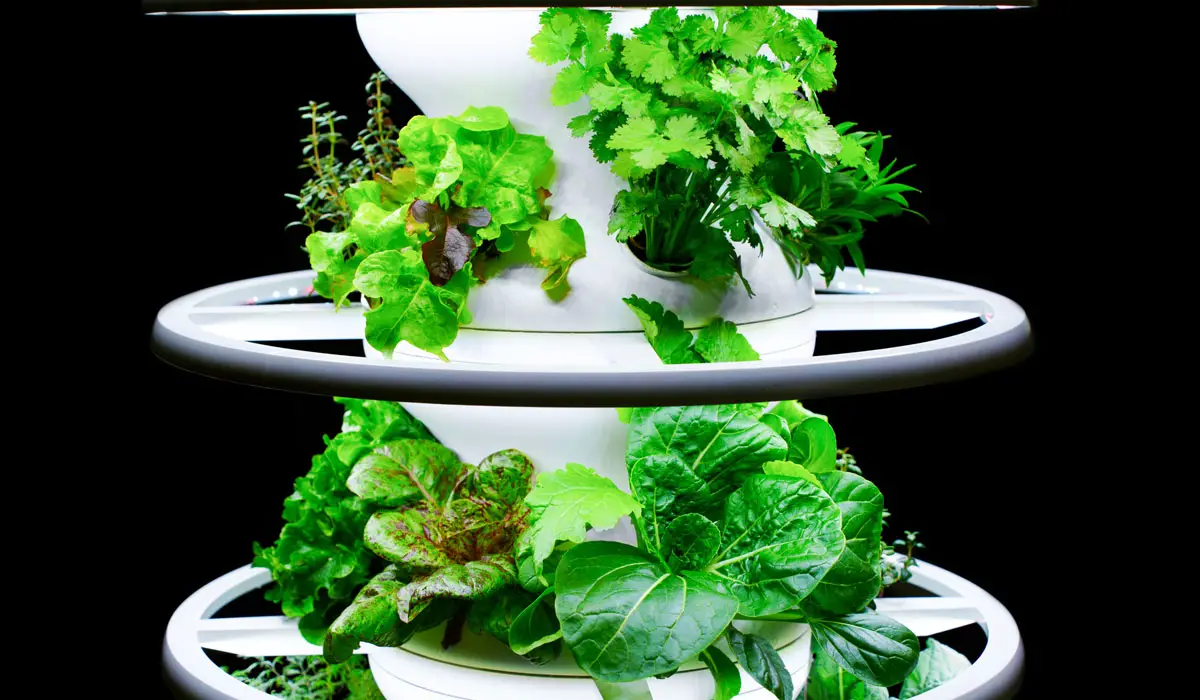
Getting Familiar with Plant Grow Light Terms
What Is a Grow Light Bulb Spectrum?
You might remember from elementary school science that visible light is made up of many different colors of light. Each color has its own wavelength, which more or less describes how energetic it is. Plants require different parts of that light spectrum to grow.
When it comes to choosing the right grow light, a good grow light needs to produce a lot of red and blue light. Red light promotes foliage growth, and grow lights that produce a lot of red will encourage leaves. Herbs like basil and vegetables like kale do just fine with LED grow lights that have a lot of red light output.
Blue light is best for flowering plants. There’s a few specialized crops that are harvested at the bud stage, but remember that flowers lead to fruit. If you want a bumper crop of strawberries or peppers, you need to make sure your bulb is producing enough blue light.
What Is a Grow Light Timer?
“By knowing how day length affects plant development in photoperiodic species, we can manipulate the natural photoperiod to promote vegetative growth (such as to bulk up plant size or for cutting production) or flowering, whichever is desired.”
Erik Runkle, University of Michigan.
A timer is an oft overlooked part of your indoor hydroponic garden, but it’s key to getting the best from your lights and from your plants. Plants need a period of darkness, just like we do. While they need light to produce their food via photosynthesis, all plants perform other biological functions during the peaceful, dark hours of the night. We call the most productive amount of light to give a hydroponic plant its ‘photoperiod’.
It might be tempting to leave your grow lights on overnights to help plants grow bigger. This can result in the opposite result, with stressed plants never really reaching their full potential. It’s particularly damaging if you’re after fruit – some crops need shorter periods of light to trigger their blooms.
Best Hydroponic Grow Light Overall
My pick for the small scale home grower is the Barrina Plant Grow Lights Reflector range, an excellent balance between affordability and practicality. They’re a bar style light, with inbuilt reflectors to ensure maximum efficiency. They can be installed in sequence, either plugged right into each other to make longer bars or via an extension cord, perfect for tight corners. They also require little effort to install, as they’re light enough for zip ties or even double sided tape. It’s this versatility that makes them my top pick for home hydroponics.
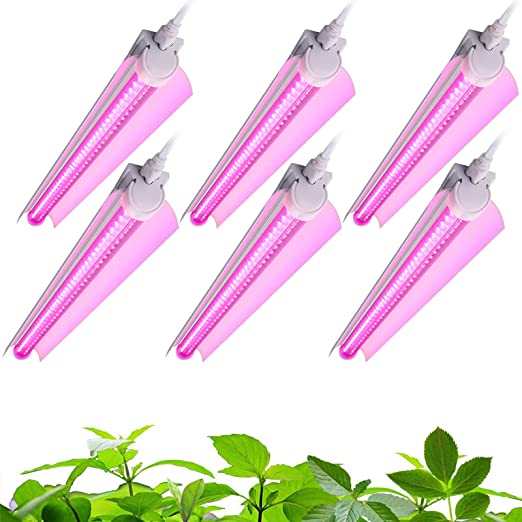
Barrina LED Grow Light
The Barrina grow light is a great full-spectrum option for plants that are in seedlings, vegetative and flowering cycles. These grow lights are affordable, easy to scale up and can fit just about anywhere.
Best LED Grow Lights on a Budget
For thrifty growers, it’s hard to go past for screw in LED bulbs their versatility and affordability. If you have a light socket, you have a grow light. Old table lamp? Grow light. Workshop light? You get the picture. As a result, I’m rather taken with the Briignite Smart LED Full Spectrum Grow Bulb. It has a host of features including a dimmer, timer function and four different light modes, all controlled via a simple remote. Just screw it in and away you go.
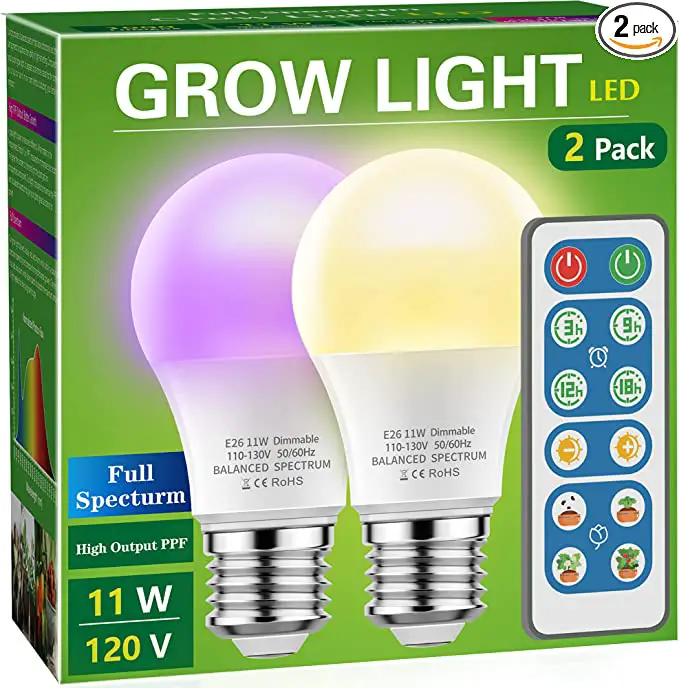
Briignite Grow Light Bulbs
The Briignite lights are perfect for supporting Kratky Jars with more light in tight spaces. The color changing options allow you trigger flowering cycles. Simply pop these into your desk or table lamp and watch your plants thrive!
If you’re more interesting in a self-contained option, the Ezorkas Tri Head LED Grow Light is perfect. It has three broad spectrum LED bars and be used free standing or clamped to a desk or workbench. They have a great balanced light spectrum ranging through white, blue and red, and can be dimmed or put on its own self contained timer. It’s another great plug-and-play option for the small scale grower.
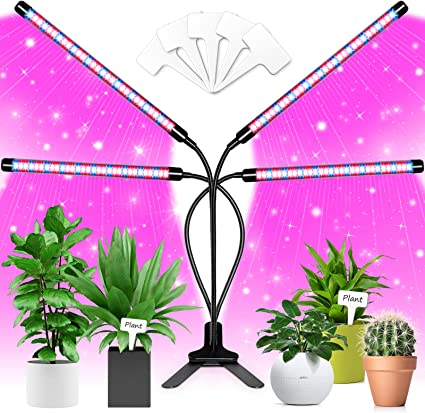
EZORKAS Dimmable Grow Light
This table top lamp includes an easily adjustable neck perfect for seedling trays or tabletop growing. 9 dimming modes makes it easy to provide light at all stages
Best Large Capacity Grow Lights
The Spider Farmer SF-4000 LED Grow Light is a hanging panel of LEDs. One set of panels will do a five foot square area of intense planting, at a greatly reduced electrical input than many other types of light. It’s a 450 watt system, and it emits a full spectrum of light, ranging through white, blue and red, as well as a good dose of infrared. It’s also adjustable and can be dimmed.
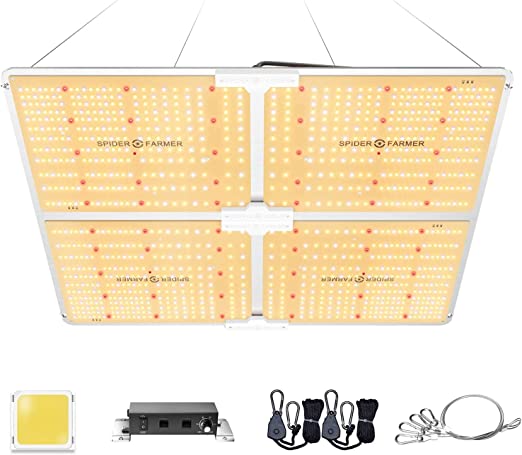
Spider Farmer SF4000
More light beads at the edges, fewer in the middle. Helping get more uniform PPFD. Plants absorb light better & product higher yields. Dimming knob is adjusted the light intensity at liberty. Veg coverage is 5 x 5 ft, Flowering coverage is 4 x4 ft.
The Mars Hydro LED 2023 New TS 3000 Grow Light is another panel style, this time with a elegantly designed reflector system that gives the most bang for your buck. Hung above your rig, it’s designed to ensure all the light it produces winds up down on the plants below. Like the SF-4000, it covers five square feet of area, but it can also be connected in sequence to extend your growing capacity as far as you like.
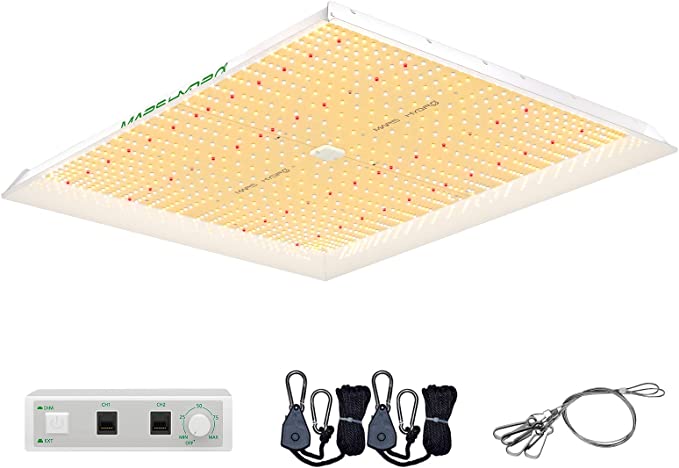
MARS HYDRO TS 3000
Consuming only 450W with 1016 LEDS! Equipped with Newest SMD LED technology to provide highest LUMEN output, designed to replace a single-ended 450watt HPS
Best Full-Spectrum LED Light
The Bestva BP1000 LED Grow Light is an absolute beast of a light panel. It provides bright, full spectrum light from a compact array of LEDs. It’s thankfully dimmable, and comes with a pulley system to elevate the panel as your plants inevitably shoot up. While there’s a few excellent full-spectrum LED grow light options on this list, The BP1000 gets the nod here for the balance of price and quality. It’s very well made and comes with a 3 year warranty.

Bestva BP2300
The Bestba BP2300 only consumes 405w, running 50% less power and 30% high yields than the HPS or other SMD LEDs or Blurple lamps. Veg footprint is 8 x 5 ft, Flowering footprint is 7 x 5 ft. Perfect for a 8×8 grow tent.
Best Blurple Grow Light
A blurple light typically specializes in the blue and purple ends of the light spectrum – high energy light that promotes blooming and fruit. The Viparspectra 600W LED Grow Light has a good, strong ‘Bloom’ setting that produces exactly this output. It’s a hanging light that also does broad spectrum and a red light ‘Veg’ mode, too. It’s a mid-price choice with a reliable, almost cult like following that swear by its ability to coax thick heads of flowers from even the most reluctant plant.
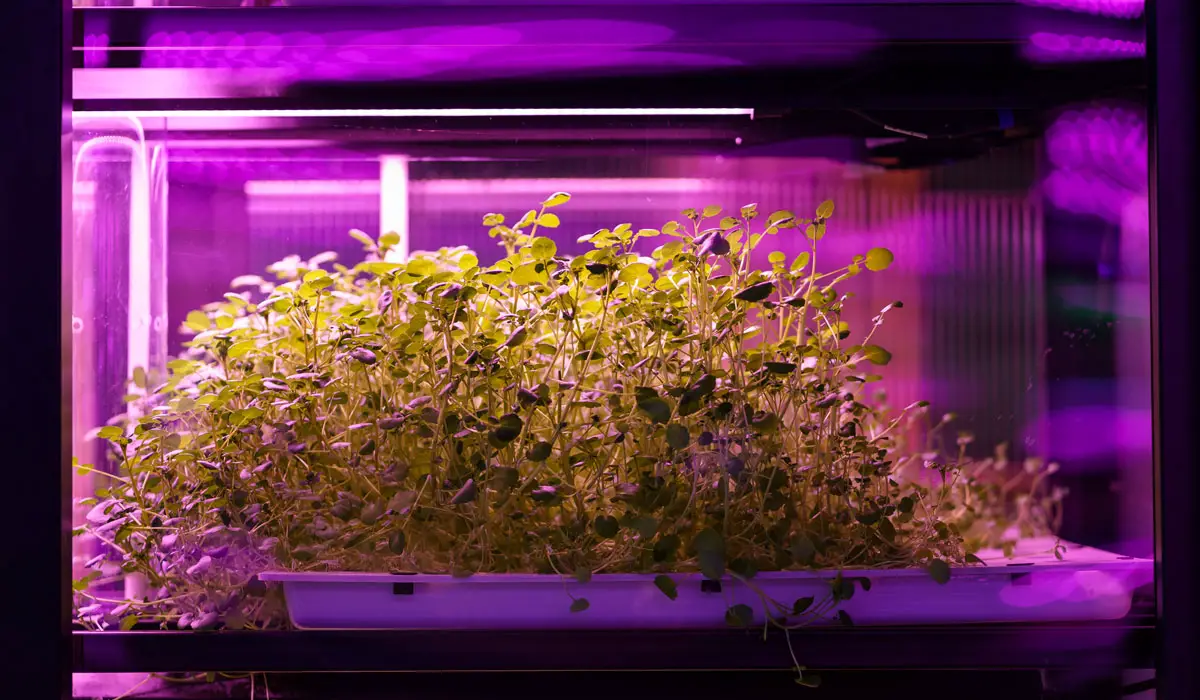
How to Choose the Best Grow Light for your Indoor Garden
Light size
The first thing to consider is the area you need to illuminate. If you only have a small rig, you only really need a small light. Conversely, a single bulb or bar just won’t cut it if your system is a sprawling, verdant wonderland.
Light spread and Reflectors
To get the most from one source of light, consider how the light will spread and if you can redirect any errant illumination. A grow light that’s shining just as brightly on walls, benches or the ceiling as it is your plants may need a bit of help to contain its power.
A reflector is exactly what it says on the tin. It’s a protective cover on one side of the light that bounces errant beams towards the plants, and not out the back of the LED fixture at walls or the roof.
Location
If you’re building your own setup, you’ll also need to work out where to put the light. Integrated systems like the Aerogarden or Gardyn do the hard work for you and have their light source built into the hydroponic system itself. But if you’re like me and enjoy tinkering up your own rig, you’ll need to think about how to place your light.
Hanging grow lights have a low footprint, and can provide illumination for bigger indoor hydroponic gardens. But they require installation and are harder to move if you need to relocate your rig. Freestanding grow lights are a versatile choice, but you’ll need to keep them dry. Grow light bulbs that plug into existing sockets are an option if you’re giving an entire room over to hydroponics, and can go into a more standard lamp if you need to stay mobile.
Bulb type
Picking your bulb type often comes down to what you need from the light and what you already have to work with. I love screw-in LED grow lights for how versatile and thrifty they are, but if you have a long Nutrient Film Technique rig you’ll do better with bar style lights for your hydroponic rig. Clip or free-standing grow lights also benefit more compact rigs, and some grow lights are designed for use in grow tents or substantial greenhouses.
Heat Output
A small grow lamp, especially an LED plant light, won’t produce much heat. Compared to incandescent bulbs or HID lights they’re practically frosty. But the bigger the artificial light, the more waste heat it will make. High-quality LED grow lights come with in built cooling systems, but a cheap LED grow light may not.
FAQ
How Long Should Grow Lights Be on For?
The duration you use your hydroponic lighting comes down to the type of plants you’re growing. Some need long intervals of up to 16 hours a day for optimal growth. Others are more efficient, and need as little as 10 hours or less. You’ll need to get a grip on what plant you’re growing first. It’s important to stress that too much light is just as bad as too little. It overwhelms the plant and slows growth.
How Far Should LED Grow Lights Be Away from Plants?
It’s best to keep your grow lights at around twenty inches away from the plant, from the top of the light to the top of the plant. This will help your indoor plants get the most from the grow light. You can either raise the light or drop the bench as plants grow taller.
How many lumens do you need for hydroponics?
The amount of light you need will largely depend on the plant you’re growing. Crops that yearn for full sun will want around 2000 to 3000 lumens, but others that prefer a shady aspect can do with less. But when considering grow lights for indoor plants, the color spectrum of the light is more important.
Final Thoughts
Here in the Great White North, full spectrum LED grow lights are often the only thing that gives us gardeners a shot at a decent growing season. That wonderful light offers us a chance to grow warm-weather crops like tomatoes and my beloved peppers without the fear of dark days damning the harvest. With the right lights to help plants along, there’s no reason at all why I can’t have the same luxurious fresh fruit and vegetables as my friends to the south.

